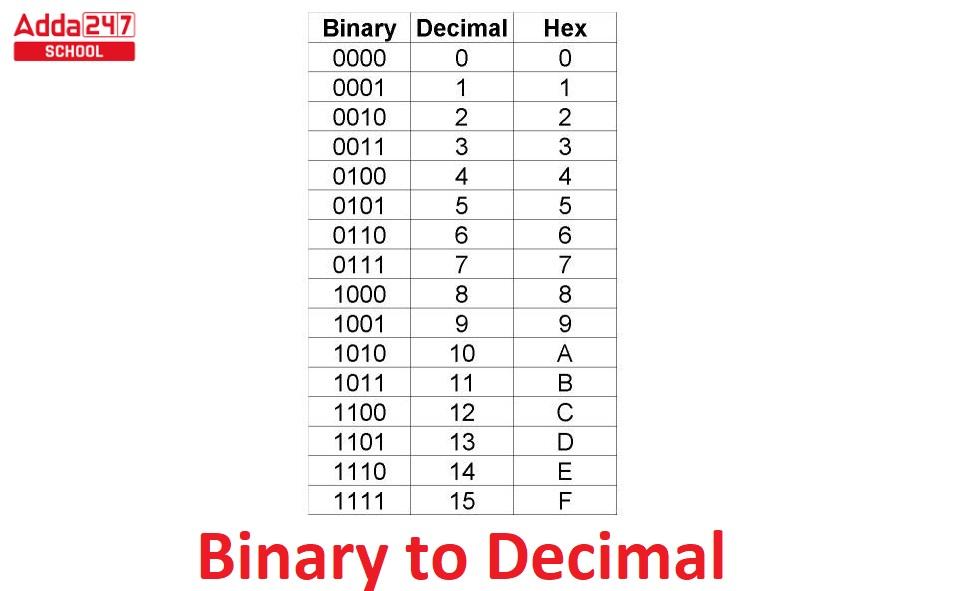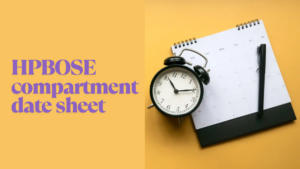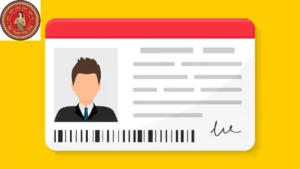Binary to Decimal
A binary number (base-2) is converted to an equivalent decimal number using the binary-to-decimal conversion formula (base-10). In mathematics, numbers are expressed using a number system. It is a way to display numerical data. The four various number systems are as follows:
- System of Binary Numbers (Base-2)
- System of octal numbers (Base-8)
- System of Decimal Numbers (Base-10)
- System of Hexadecimal Numbers (Base-16)
The number system is crucial to computer systems. The number system is used by virtually all electronic devices, not just computer architecture. Therefore, learning how to convert between different number systems is crucial. Before we talk about converting from binary to decimal, let’s first grasp both number systems.
Binary Number System
A number that is employed in binary systems is referred to as a binary number system. The base 2 number system is another name for it. It uses two separate symbols to represent the numerical values, essentially 1 (one) and 0 (zero).
Decimal Number System
The base-10 numeral system is another name for the decimal number system. Ten digits, from 0 to 9, are used. The continuous locations to the left of the decimal point in the decimal number system stand in for units, tens, hundreds, thousands, and so forth. Consequently, 10 serves as the decimal number system’s base.
Binary to Decimal Conversion
When converting a binary number (base-2) to a decimal number, this process is known as binary to decimal conversion (base-10). Understanding binary-to-decimal conversion is crucial for applications using computer programming. Only two digits, 0 and 1, are used to represent the binary number system, whereas all ten digits, from 0 to 9, are used to represent the decimal number system. In the subsequent section, we must learn how to translate a binary number into its matching decimal number.
Know: Parts of Computer Name and Their Functions For Kids
How Binary to Decimal Converter Works?
We use the division method to multiply the binary integer to get its decimal equivalent. In this conversion method, each digit of the input number is multiplied from the Most Significant Bit (MSB) to the Least Significant Bit (LSB), lowering the base’s power, if a number with base n is to be turned into a number with base 10.
Binary to Decimal Conversion Steps
- Write the specified binary number first, then count the powers of two going left to right (powers starting from 0)
- Now, from right to left, write each binary digit with the matching powers of 2, so that the first binary digit (MSB) will be multiplied by the largest power of 2.
- Add each of the items from the previous step.
- The required decimal number will be the final response.
Check: Wi-Fi Full Form in Computer Network {English and Hindi}
Binary to Decimal Converter working Formula
We will learn the basic formula, let’s study how to convert a binary number to a decimal number. The formula to convert binary to decimal is provided as, where dn represents the digits of a binary number with ‘n’ digits.
The formula for conversing binary to decimal is given below

Where,
N is decimal equivalent,
b is the digit,
q is the base value
Binary to Decimal Table
| Binary Number |
Decimal Number |
Hex Number |
|---|---|---|
| 0 | 0 | 0 |
| 1 | 1 | 1 |
| 10 | 2 | 2 |
| 11 | 3 | 3 |
| 100 | 4 | 4 |
| 101 | 5 | 5 |
| 110 | 6 | 6 |
| 111 | 7 | 7 |
| 1000 | 8 | 8 |
| 1001 | 9 | 9 |
| 1010 | 10 | A |
| 1011 | 11 | B |
| 1100 | 12 | C |
| 1101 | 13 | D |
| 1110 | 14 | E |
| 1111 | 15 | F |
| 10000 | 16 | 10 |
| 10001 | 17 | 11 |
| 10010 | 18 | 12 |
| 10011 | 19 | 13 |
| 10100 | 20 | 14 |
| 10101 | 21 | 15 |
| 10110 | 22 | 16 |
| 10111 | 23 | 17 |
| 11000 | 24 | 18 |
| 11001 | 25 | 19 |
| 11010 | 26 | 1A |
| 11011 | 27 | 1B |
| 11100 | 28 | 1C |
| 11101 | 29 | 1D |
| 11110 | 30 | 1E |
| 11111 | 31 | 1F |
| 100000 | 32 | 20 |
| 1000000 | 64 | 40 |
| 10000000 | 128 | 80 |
| 100000000 | 256 | 100 |
Binary to Decimal Table
The conversion chart for Binary to Decimal conversion is given below
| Binary | Decimal |
| 0 | 0 |
| 1 | 1 |
| 10 | 2 |
| 11 | 3 |
| 100 | 4 |
| 101 | 5 |
| 110 | 6 |
| 111 | 7 |
| 1000 | 8 |
| 1001 | 9 |
| 1010 | 10 |
| 1011 | 11 |
| 1100 | 12 |
Binary to Decimal Conversion Examples
Example: Convert 11102, from binary to decimal using the binary-to-decimal formula.
Solution: We start doing the conversion from the rightmost digit, which is ‘0’ here.
(Decimal Number)10 = (d0 × 20) + (d1 × 21 )+ (d2 × 22 )+ ….. (dn-1 × 2n-1),
= (0 × 20) + (1 × 21) + (1 × 22) + (1 × 23)
= (0 × 20) + (1 × 21) + (1 × 22) + (1 × 23)
= 0 + 2 + 4 + 8
= 14
Therefore, 11102 = 1410
Example: Convert the binary number 1001 to a decimal number.
Solution: Given, binary number = 10012
Hence, using the binary-to-decimal conversion formula, we have:
10012 = (1 × 2³) + (0 × 2²) + (0 × 2¹) + (1 × 2⁰)
= 8 + 0 + 0 + 1
= (9)₁₀
Example: Convert 11010012 into an equivalent decimal number.
Solution: Using binary to decimal conversion method, we get;
(1101001)₂ = (1 × 2⁶) + (1 × 2⁵) + (0 × 2⁴) + (1 × 2³) + (0 × 2²) + (0 × 2¹) + (1 × 2⁰)
= 64 + 32 + 0 + 8 + 0 + 0 + 1
= (105)₁₀
1111 Binary to Decimal
1111 is in binary to decimal conversion is equal to 15.
| 1111 | 15 |
11111 Binary to Decimal
To convert the binary number 11111 to decimal, we can use the positional value of each bit. Starting from the right, each bit represents a power of 2, with the rightmost bit representing
2020.
1001 Binary to Decimal Conversion
In The binary conversion of 1001 means the 1 and the 8 bits are activated, but not the 2 or 4 bits. Thus, the binary-to-decimal conversion for 1001 is 8 + 1 = 9.









 HPBOSE Compartment Date Sheet 2025 Out, ...
HPBOSE Compartment Date Sheet 2025 Out, ...
 RUHS Counselling 2025 Round 1 Seat Allot...
RUHS Counselling 2025 Round 1 Seat Allot...
 Bihar Board Dummy Registration Card 2026...
Bihar Board Dummy Registration Card 2026...










